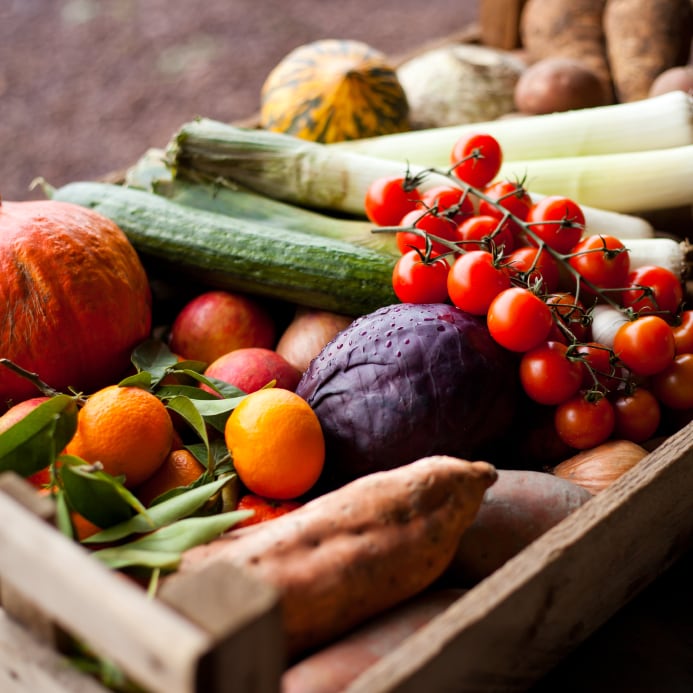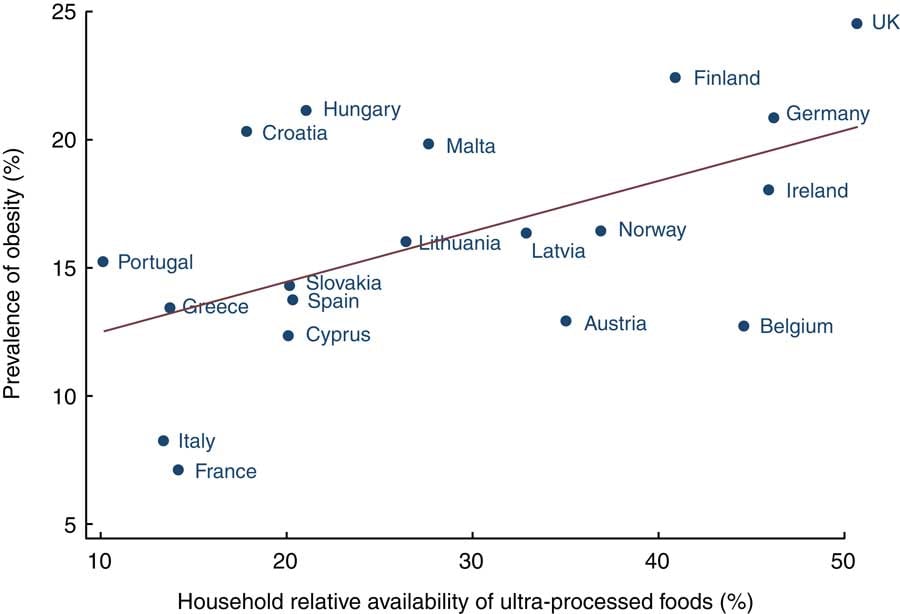Hyper-palatable and attractive, with a long shelf-life and energy-dense nutritional profile, ultra-processed foods are designed to be eaten anywhere, any time - and they are contributing to Europe's expanding waistline.
“The association between consumption of ultra-processed foods and obesity is consistent with the obesogenic nutritional profile of these foods,” wrote lead author Carlos Augusto Monteiro from the University of São Paulo's School of Public Health.

Using national surveys, reports and peer-reviewed papers, the researchers estimated the prevalence of obesity in Austria, Belgium, Croatia, Cyprus, Finland, France, Germany, Greece, Hungary, Ireland, Italy, Latvia, Lithuania, Malta, Norway, Portugal, Slovakia, Spain and the UK.
They then compared this with food data taken from the Data Food Networking (DAFNE) for all countries apart from the UK, which used the Living Costs and Food Survey (LCFS).
Prevalence of obesity ranged from 7.1% in France and 8.2% in Italy, which also had the lowest levels of ultra-processed foods, to nearly one quarter (24.5%) in the UK, which also had the highest intake of ultra-processed foods.
Germany, where 46.2% of total dietary energy came from ultra-processed foods, also had a high obesity rate.
“The findings reinforce the need for public policies and actions that promote consumption of unprocessed or minimally processed foods and make ultra-processed foods less available and affordable,” wrote the authors.
The comparison also threw up a few anomalies, however. Portugal, for instance, had the lowest level of ultra-processed foods but a relatively high obesity rate, as did Greece.
"Obesity is determined by many factors, not only the level of consumption of ultra-processed foods. But the increasing worldwide consumption of [these] foods is a very powerful and preventable driver of the present obesity pandemic and this is probably the most important aspect to consider in public policies," Monteiro told FoodNavigator.

'Convert ultra-processed to processed'
“A healthy diet only can be based on fresh or minimally processed foods,” he added. “Processed foods, such as breads and cheese, and processed culinary ingredients such as oils, fats and salt contribute to diversification of tastes and convenience and are ok as complements of fresh or minimally processed foods.”
Monteiro’s message to the food industry? “Convert ultra-processed products into processed products when this is feasible and get rid of the other products!”
The researcher said he had “no doubt” regulatory action, such as taxes and mandatory reformulation, were necessary for this to happen.
The NOVA food groups
The NOVA classification system, devised in 2009 by Monteiro, includes four groups.
Unprocessed or minimally processed foods in group one include as fresh, dry or frozen fruit and vegetables; packaged grains and pulses; flours made from corn, wheat, rye; pasta; eggs; fresh or frozen meat and fish and milk.
Group two includes processed culinary ingredients such as sugar, oils, fats, salt and other substances extracted from foods or nature used to season and cook.
Group three is made up of processed foods such as vegetables in brine, fruits in syrup, salted meat and fish, cheese and freshly made unpackaged breads.
Ultra-processed foods in group four, meanwhile, contains soft drinks, packaged snacks and confectionery; mass-produced packaged breads; reconstituted meat such as hot dogs and chicken nuggets, instant soups and noodles and industrially pre-prepared pizzas, pies and ready meals.
“They are also aggressively marketed often in big portion sizes and are typically designed to be consumed as snacks rather than as regular meals. All these factors induce energy over-consumption and thus overweight and obesity," write the authors.
Dietary differences
The most commonly purchased unprocessed or minimally processed foods in Europe were meat, milk, pasta and flours while the most commonly eaten ultra-processed foods were packaged bread, sweet baked goods, reconstituted meats and sugar-sweetened beverages.
However, the surveys highlighted big differences in eating habits from country to country. Cakes, cookies and other baked goods made up 0.4% of Croatians’ total energy intake but 11.1% of Belgians while reconstituted meat accounts for 1.5% of an average Greek’s diet but 14% in Germany.
Sugar-sweetened beverages were most popular in Latvia (11%) and least popular in Italy (0.1%).
Packaged breads accounted for 16.3% of the average Irish person’s total energy compared to 1.6% in Malta.
Are the ingredients 'kitchen cupboard' or 'factory floor'?
The researchers said that in Europe some foods, such as bread, could be in either group three or four.
Processed bread is made with flour, yeast, water and salt (with the addition of dried fruit or olives, for instance) but a lot of the bread eaten in Europe is made industrially and includes ‘factory only’ ingredients such as hydrogenated fat, high-fructose corn syrup, emulsifiers, preservatives, flavours, colours and other additives.
Monteiro and the researchers noted some limitations of the study. Almost half of the obesity estimates relied on self-reported data, and were therefore likely to underestimate the true prevalence. Furthermore, food purchase surveys do not include food eaten outside the home, or for the amount of food bought but not eaten, lost to domestic food waste.
Brazil’s ‘remarkable’ dietary guidelines
In Monteiro’s native Brazil, national dietary guidelines place an emphasis on home cooking, meal times and less ‘ultra-processed’ food, winning the praise of food policy experts around the world.
When the revised version was published in 2014, food policy commentator Professor Marion Nestle described it as “remarkable” in a blog post on Food Politics.
Brazil's national dietary guidelines
1. Make natural or minimally processed foods the basis of your diet
2. Use oils, fats, salt, and sugar in small amounts when seasoning and cooking natural or minimally processed foods and to create culinary preparations
3. Limit consumption of processed foods
4. Avoid consumption of ultra-processed foods
5. Eat regularly and carefully in appropriate environments and, whenever possible, in company
6. Shop in places that offer a variety of natural or minimally processed foods
7. Develop, exercise and share cooking skills
8. Plan your time to make food and eating important in your life
9. Out of home, prefer places that serve freshly made meals
10. Be wary of food advertising and marketing
(Source: FAO’s Food-based dietary guidelines – Brazil)
Source: Public Health Nutrition
“Household availability of ultra-processed foods and obesity in nineteen European countries”
Published online: 17 July 2017, doi.org/10.1017/S1368980017001379
Authors: Carlos Augusto Monteiro, Jean-Claude Moubarac, Renata Bertazzi Levy, Daniela Silva Canella, Maria Laura da Costa Louzada, Geoffrey Cannon.
